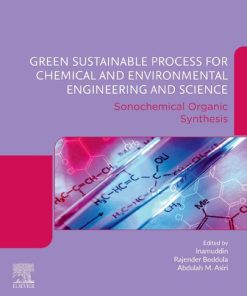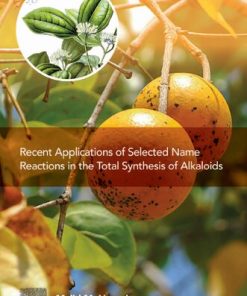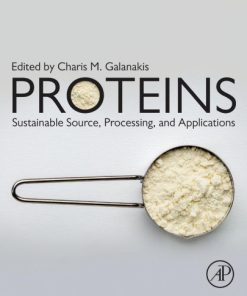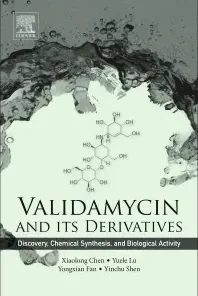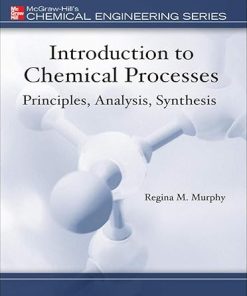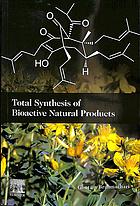Total Chemical Synthesis of Proteins 1st Edition by Ashraf Brik 3527823581 9783527823581
$50.00 Original price was: $50.00.$25.00Current price is: $25.00.
Total Chemical Synthesis of Proteins 1st Edition by Ashraf Brik – Ebook PDF Instant Download/DeliveryISBN: 3527823581 9783527823581
Full download Total Chemical Synthesis of Proteins 1st Edition after payment.
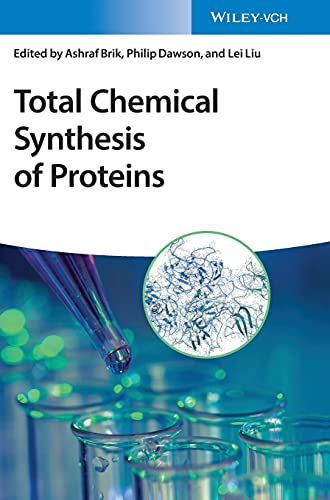
Product details:
ISBN-10 : 3527823581
ISBN-13 : 9783527823581
Author : Ashraf Brik
How to synthesize native and modified proteins in the test tube With contributions from a panel of experts representing a range of disciplines, Total Chemical Synthesis of Proteins presents a carefully curated collection of synthetic approaches and strategies for the total synthesis of native and modified proteins. Comprehensive in scope, this important reference explores the three main chemoselective ligation methods for assembling unprotected peptide segments, including native chemical ligation (NCL). It includes information on synthetic strategies for the complex polypeptides that constitute glycoproteins, sulfoproteins, and membrane proteins, as well as their characterization. In addition, important areas of application for total protein synthesis are detailed, such as protein crystallography, protein engineering, and biomedical research. The authors also discuss the synthetic challenges that remain to be addressed. This unmatched resource: Contains valuable insights from the pioneers in the field of chemical protein synthesis Presents proven synthetic approaches for a range of protein families Explores key applications of precisely controlled protein synthesis, including novel diagnostics and therapeutics Written for organic chemists, biochemists, biotechnologists, and molecular biologists, Total Chemical Synthesis of Proteins provides key knowledge for everyone venturing into the burgeoning field of protein design and synthetic biology.
Total Chemical Synthesis of Proteins 1st Table of contents:
1 Characterization of Protein Molecules Prepared by Total Chemical Synthesis
1.1 Introduction
1.2 Chemical Protein Synthesis
1.3 Comments on Characterization of Synthetic Protein Molecules
1.4 Summary
References
Note
2 Automated Fast Flow Peptide Synthesis
2.1 Introduction
2.2 Results
2.3 Conclusions
Acknowledgments
References
3 N,S‐ and N,Se‐Acyl Transfer Devices in Protein Synthesis
3.1 Introduction
3.2 N,S‐ and N,Se‐Acyl Transfer Devices: General Presentation, Reactivity and Statistical Overview of Their Utilization
3.3 Preparation of SEA/SeEAoff and SEAlide Peptides
3.4 Redox‐controlled Assembly of Biotinylated NK1 Domain of the Hepatocyte Growth Factor (HGF) Using SEA and SeEA Chemistries
3.5 The Total Chemical Synthesis of GM2‐AP Using SEAlide‐based Chemistry
3.6 Conclusion
References
4 Chemical Synthesis of Proteins Through Native Chemical Ligation of Peptide Hydrazides
4.1 Introduction
4.2 Development of Peptide Hydrazide‐based Native Chemical Ligation
4.3 Optimization of Peptide Hydrazide‐based Native Chemical Ligation
4.4 Application of Peptide Hydrazide‐based Native Chemical Ligation
4.5 Summary and Outlook
References
5 Expanding Native Chemical Ligation Methodology with Synthetic Amino Acid Derivatives
5.1 Native Chemical Ligation
5.2 Desulfurization Chemistries
5.3 Aspartic Acid (Asp, D)
5.4 Glutamic Acid (Glu, E)
5.5 Phenylalanine (Phe, F)
5.6 Isoleucine (Ile, I)
5.7 Lysine (Lys, K)
5.8 Leucine (Leu, L)
5.9 Asparagine (Asn, N)
5.10 Proline (Pro, P)
5.11 Glutamine (Gln, Q)
5.12 Arginine (Arg, R)
5.13 Threonine (Thr, T)
5.14 Valine (Val, V)
5.15 Tryptophan (Trp, W)
5.16 Application of Selenocysteine (Sec) to Ligation Chemistry
5.17 Aspartic Acid (Asp, D)
5.18 Glutamic Acid (Glu, E)
5.19 Phenylalanine (Phe, F)
5.20 Leucine (Leu, L)
5.21 Proline (Pro, P)
5.22 Serine (Ser, S)
References
6 Peptide Ligations at Sterically Demanding Sites
6.1 Introduction
6.2 Ligations Using Thioesters
6.3 Ligations Using Oxo‐esters
6.4 Peptide Ligations Based on Selenoesters
6.5 Microfluidics‐promoted NCL
6.6 Representative Applications in Protein Synthesis
6.7 Summary and Outlook
References
7 Controlling Segment Solubility in Large Protein Synthesis
7.1 Solvent Manipulation
7.2 Isoacyl Strategy
7.3 Semipermanent Solubilizing Tags
References
Note
8 Toward HPLC‐free Total Chemical Synthesis of Proteins
8.1 Introduction
8.2 Synthesis of Peptide Segments for Native Chemical Ligation
8.3 Synthesis of Proteins Using the His6 Tag
8.4 Synthesis of Proteins via Oxime Formation
8.5 Synthesis of Proteins via Hydrazone Formation
8.6 Synthesis of Proteins Using Click Chemistry
8.7 Synthesis of Proteins Using the KAHA Ligation
8.8 Synthesis of Proteins Using Photocleavable Tags
8.9 Conclusion
References
9 Solid‐phase Chemical Ligation
9.1 Introduction
9.2 SPCL in the C‐to‐N Direction
9.3 SPCL in the N‐to‐C Direction
9.4 Post‐Ligation Solid‐Supported Transformations
9.5 Solid Support
9.6 Conclusion and Perspectives
Acknowledgment
9.A Appendix
References
10 Ser/Thr Ligation for Protein Chemical Synthesis
10.1 Serine/Threonine Ligation
10.2 Epimerization Issue
10.3 Other Aryl Aldehyde Esters
10.4 Preparation of Peptide Salicylaldehyde Esters
10.5 Scope and Limitations
10.6 Strategies of Ser/Thr Ligation for Protein Chemical Synthesis
10.7 C‐to‐N Ser/Thr Ligation
10.8 N‐to‐C Ser/Thr Ligation
10.9 One‐pot Ser/Thr Ligation and NCL
10.10 Bioconjugation
10.11 Solubility Issues
10.12 Extension of Ser/Thr Ligation
10.13 Conclusion
References
11 Protein Semisynthesis
11.1 Background
11.2 Expressed Protein Ligation (EPL)
11.3 Cysteine Modifications
11.4 Enzyme‐catalyzed Protein/Peptide Ligations
11.5 Enzyme‐catalyzed Expressed Protein Ligation
11.6 Summary and Outlook
Acknowledgments
References
12 Bio‐orthogonal Imine Chemistry in Chemical Protein Synthesis
12.1 Introduction
12.2 Carbonyl Functionalization
12.3 Aminooxy, Hydrazine, and Hydrazide Functionalization
12.4 Oxime Ligation
12.5 Hydrazone Ligation
12.6 Pictet–Spengler Reaction
12.7 Catalysis of Oxime and Hydrazone Ligations
References
13 Deciphering Protein Folding Using Chemical Protein Synthesis
13.1 Introduction
13.2 Modification of Protein Backbone Amides
13.3 Insertion of β‐turn Mimetics
13.4 Inversion of Chiral Centers in Protein Backbone and Side Chains
13.5 Modulating cis–trans Proline Isomerization
13.6 Steering Oxidative Protein Folding
13.7 Covalent Tethering to Facilitate Folding of Designed Proteins
13.8 Discovery of Previously Unknown Protein Folds
13.9 Site‐specific Labeling with Fluorophores
13.10 Foldamers and Foldamer–Peptide Hybrids
13.11 Conclusions and Outlook
Acknowledgement
References
14 Chemical Synthesis of Ubiquitinated Proteins for Biochemical Studies
14.1 The Ubiquitin System
14.2 Non‐enzymatic Ubiquitination: Challenges and Opportunities
14.3 Synthesis and Semisynthesis of Ubiquitinated Proteins
14.4 Synthesis of Unique Ub Conjugates to Study and Target DUBs
14.5 Activity‐based Probes
14.6 Perspective
List of Abbreviations
References
15 Glycoprotein Synthesis
15.1 Introduction
15.2 Total Chemical Synthesis of Glycoproteins
15.3 Semisynthesis of Glycoproteins
15.4 Chemoenzymatic Synthesis
15.5 α‐Synuclein
15.6 Hirudin P6
15.7 Saposin D
15.8 Interleukin 2
15.9 Interleukin 25
15.10 Mucin 1
15.11 Crambin
15.12 Tau Protein
15.13 Chemical Domain of Fractalkine
15.14 CCL1
15.15 Interleukin 6
15.16 Interleukin 8
15.17 Erythropoietin
15.18 Trastuzumab
15.19 Antifreeze Glycoprotein
15.20 Conclusion
References
16 Chemical Synthesis of Membrane Proteins
16.1 Introduction
16.2 Solid Phase Synthesis of TM Peptides
16.3 Purification and Handling Strategies of TM Peptides
16.4 Solubility Tags
16.5 Removable Solubilizing Backbone Tags
16.6 Chemical Synthesis of Membrane Proteins
16.7 Outlook
References
17 Chemical Synthesis of Selenoproteins
17.1 What are Selenoproteins?
17.2 Expression of Selenoproteins
17.3 Sec as a Reactive Handle
17.4 Synthesis and Semisynthesis of Natural Selenoproteins
17.5 Selenium as a Tool for Protein Folding
17.6 Conclusions
References
18 Histone Synthesis
18.1 The Histones and Their Chemical Modifications
18.2 Chemical Ligation for Histone Synthesis
18.3 Histone Octamer and Nucleosome Core Particle Assembly
18.4 Studying the Histone Code With Synthetic Histones
18.5 Conclusions
Acknowledgments
References
19 Application of Chemical Synthesis to Engineer Protein Backbone Connectivity
19.1 Introduction
19.2 Backbone Engineering to Facilitate Synthesis
19.3 Backbone Engineering to Explore the Consequences of Chirality
19.4 Backbone Engineering to Understand and Control Folding
19.5 Backbone Engineering to Create Protein Mimetics
19.6 Conclusions
References
20 Beyond Phosphate Esters: Synthesis of Unusually Phosphorylated Peptides and Proteins for Proteomic Research
20.1 Introduction
20.2 General Methods for the Incorporation of Hydroxy‐phosphorylated Amino Acids into Peptides and Proteins
20.3 Incorporation of Other Phosphorylated Nucleophilic Amino Acids into Peptides and Proteins
20.4 Development of Phospho‐analogues as Mimics for Endogenous Phospho‐Amino Acids
20.5 Conclusion
References
21 Cyclic Peptides via Ligation Methods
21.1 Introduction
21.2 Cyclic Peptide Synthesis
21.3 Orbitides
21.4 Paws‐derived Peptides(PDPs)
21.5 Cyclic Conotoxins
21.6 θ‐Defensins
21.7 Cyclotides
21.8 Outlook
People also search for Total Chemical Synthesis of Proteins 1st:
what is chemical synthesis
which element is used in the synthesis of proteins
total synthesis
total synthesis meaning
total synthesis of taxol
Tags:
Total Chemical,Synthesis,Proteins,Ashraf Brik
You may also like…
Science (General)
Proteins: Sustainable Source, Processing and Applications 1st Edition
Business & Economics
Money: Understandings and Misunderstandings 1st ed. 2020 Edition Mohammad Ashraf
Science (General)
Chemistry
Introduction to Chemical Processes: Principles, Analysis, Synthesis 2nd Edition Regina Murphy
Science (General)




